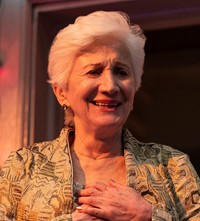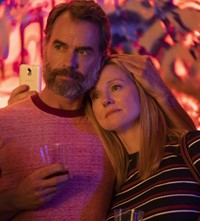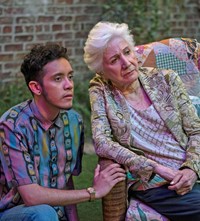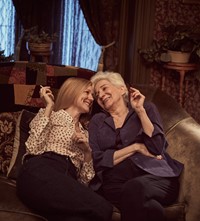“It’s the sense that we can create our own families when our traditional families fail us,” says Armistead Maupin as his beloved series, Tales of the City, returns on Netflix – with Laura Linney and Olympia Dukakis back in the starring roles
- TextNick Levine
Though he was raised in Raleigh, North Carolina, and retains the warm manners of a Southern gent, Armistead Maupin will forever be synonymous with San Francisco. Tales of the City, his serialised story published daily in the San Francisco Chronicle in the late 70s and 80s, was an affectionate and dazzling reflection of the city’s bohemian streak. It introduced readers to a world where queer and straight folks came together to form their own “logical family” – to borrow a term Maupin himself would later coin – and a joint taped to your apartment door was a show of affection. Wild, witty and inclusive, Tales has been charming readers for more than 40 years; it’s also an iconic and important part of queer culture.
Over the years, the franchise has spawned standalone novels, a stage musical co-written by Jake Shears, and three miniseries starring Laura Linney as earnest but determined heroine Mary Ann Singleton and Olympia Dukakis as matriarch-landlady Anna Madrigal. Now, Tales of the City has been revived by Netflix. Exec-produced by Orange Is the New Black writer Lauren Morelli and Maupin himself, the new ten-part series teams old faves like Mary Ann and Anna with a new and diverse group of younger characters from across the LGBTQ spectrum. Ahead of its premiere, I sat down with Maupin – who’s beautifully dressed and, somewhat shockingly, in the process of moving to London – to hear the whole Tales of the City story from the 70s to today.
NL: Back in 1976, did you pitch Tales of the City to the San Francisco Chronicle, or did the newspaper approach you?
AM: No, I had done them for a weekly newspaper in Marin County – they were standalone stories. The first one was Mary Ann Singleton at the Marina Safeway. And the paper folded after about four episodes, so I decided to take it to the Chronicle as a proposal. And they asked me to do it five days a week. I just had to say that I could, even though I had no idea how I would. I would take two of the characters and put them in Mrs Madrigal’s kitchen and have them talk to each other. And it would grow out of that. To this day it’s kind of how I plot anyway. You have to write a story into the unknown and see where it takes you.
NL: Some of the things that happen in the early books are still pretty mind-blowing. You even had a white character [D’orothea Wilson] taking pills to change her skin tone so she could pretend to be black.
AM: Well, Rachel Dolezal did – I predicted her! Yeah, I was shopping for those kind of things. And once people realised, they would almost audition for it. They’d say ‘wait until you see the pick-up scene at the Come Clean Center Laundromat’. So I would go down to these places and immerse myself and see where the story and the characters would take me.
NL: Why do you think Tales continues to move new readers 43 years later?
AM: The tagline [for the new series] says it pretty well: ‘Home is a feeling.’ It’s the sense that we can create our own families when our traditional families fail us. And that’s not just queer folk, but anybody who’s felt that they really don’t wanna go visit their parents in Idaho. It’s the way we live now, and I think that’s chiefly the thing it does.
NL: It’s another way in which Tales was massively ahead of the curve.
AM: Well, I didn’t want to say that in case it sounded a little pompous. But yes, I did fucking predict this! I didn’t know what I was doing; I was just writing about my life and how I was loving it, which was the truth. I was so happy when I arrived in San Francisco and began to meet wonderful people and have the kind of sex I wanted and make the friendships I wanted. It was my city. Everyone’s got one, a city that forms them, and San Francisco was mine. But I didn’t see any need to stay there when we decided to move to London because San Francisco is very much in my heart: the whole experience and many of the friends.
NL: Were you totally on board with the original Tales of the City miniseries in 1993?
AM: Oh, I was on board. I wanted it to happen. We were approached by Andrew Lloyd Webber’s television company and by Working Title. I’d seen Working Title’s work in the movies so that was the obvious choice. But [the idea to make it into a TV series] was around for a while. Warner Brothers optioned it in 1978 and wanted to do all sorts of dreadful things to it.
NL: Like what?
AM: Like eliminate the gay people. I told them my work without gay people is like Dickens’ work without poor people – it’s not gonna work. I was modestly comparing myself to Dickens, of course. The times took a long time to catch up, but I’m happy they have. It’s pretty exciting to see all the things that can be done on this Netflix production. But [with the original series] there were protests every step of the way. It was condemned on the floor of Congress for God’s sake by a bunch of right-wing Congressmen, which did nothing but help me. I highly recommend that. If you piss off a bunch of old farts, you’re guaranteed to get some publicity out of it.
NL: Had they even seen the series, do you think?
AM: They watched a 12-minute video tape from the American Family Association that contained every bare boob and male-on-male kiss in the show. I hate to think how that might have been used by some of those old Republicans... I bet they locked the doors before they looked at it. In general, they knew it had queers and dope in it, and a whole other bunch of things that make life worth living, and they had a constituency that they could rile up and get votes. It’s the same way it works in America now.
NL: Did you ever think, 26 years later, there’d be another Tales of the City series?
AM: Well actually, Andrew Stern from Working Title approached me about getting it up again and that was exciting to me because obviously Working Title had done it in the first place. So that started the ball rolling again. That was about four years ago, and then there was a history I cannot even remember of getting all the pieces in place and finally taking it to Netflix and having them say yes.
NL: Were there particular challenges in adapting Tales for TV in 2019?
AM: It was easier. We had an all-queer writing room. What a luxury! We had everybody [from the LGBTQ community] in that room, and we set out to do that. We set out to get a trans man in the writers’ room. And I hate to give Pat Resnick the title of ‘old lesbian’, but that’s what she is, and a fine old lesbian she is too. This is the woman that created 9 to 5. We were a varied and interesting bunch in the writers’ room and as a consequence stories emerged that might not have emerged if people hadn’t been bringing their own experiences. But we had the same producer [as before] Alan Poul. And that’s provided a continuity that’s completely necessary, really, because he’s somebody who understood the characters even when the casting changed.
NL: Was it imperative that Laura Linney and Olympia Dukakis both reprised their roles from the original series?
AM: Oh yeah. Fortunately, both of them feel great loyalty and devotion to the piece. It was a seminal thing in both of their careers. Olympia says Anna Madrigal is her favourite character, and it’s sort of the way we found out about Laura.
NL: After the sixth Tales of the City novel, 1989’s Sure of You, you didn’t write another until 2007’s Michael Tolliver Lives. Was there ever a time you thought you’d finished with Tales forever?
AM: Well, to be honest, I kind of put it to bed after number six, because it was during the worst moment of the Aids epidemic where we all believed that anybody who was HIV positive was going to die. I had already established Michael Tolliver as HIV positive and didn’t want to see him through his death. I felt that what he had to offer the world was as a living, happy gay man. So when I finally returned to Tales, the novel was called Michael Tolliver Lives, to celebrate the fact that so many [HIV positive] people were beginning to experience the effect of the drugs cocktails and weren’t automatically dying. And I was ready to come back to it, and it made sense to come back to it, because Mary Ann arrives in book one, and leaves in book six.
NL: I’m so glad that in the later novels, and in the new series, Mary Ann kind of gets a redemption. I never thought she was so awful.
AM: I didn’t either. I once had a three-way in Paris – that sounds like a Joni Mitchell song – with a couple of guys who’d met me at a book signing. I didn’t pick them up at the book signing, I’d hasten to add, I was at a bar nearby afterwards, drinking Pastis which I hadn’t experienced before and which were very strong. So we went back to my hotel, I guess, and after we had played, the two of them got into an argument with each other. They had the courtesy to argue in English so I could hear. It was all, ‘You ask him!’ ‘No, you ask him!’ They were having this huge fight, so eventually I said: ‘What is it that you want to know?’ And somebody replied: ‘Why did Mary Ann become such a bitch?’ And I get asked that question as much as anything. But I’ve never thought that she did. Though when I read Sure of You, she’s pretty dreadful towards the end. But you know, I understand her. Because in many ways, she’s me.
NL: Are you allowed to have a favourite Tales character?
AM: Oh no, it can’t be like that. I have to like them all, for various reasons, and believe in them all.
Armistead Maupin’s Tales of the City launches on Netflix today.















